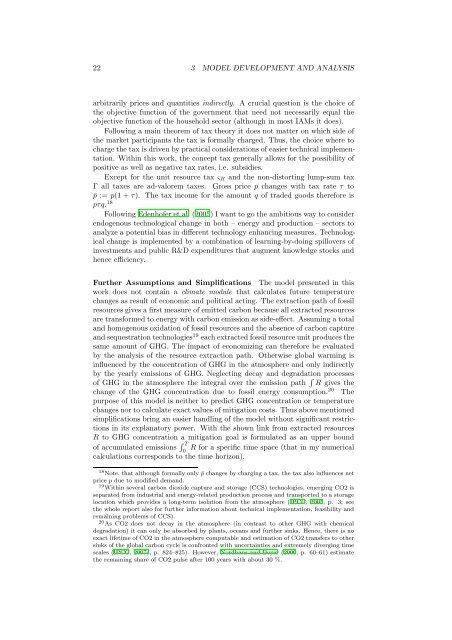Modeling Climate Policy Instruments in a Stackelberg Game with ...
Modeling Climate Policy Instruments in a Stackelberg Game with ...
Modeling Climate Policy Instruments in a Stackelberg Game with ...
Create successful ePaper yourself
Turn your PDF publications into a flip-book with our unique Google optimized e-Paper software.
22 3 MODEL DEVELOPMENT AND ANALYSIS<br />
arbitrarily prices and quantities <strong>in</strong>directly. A crucial question is the choice of<br />
the objective function of the government that need not necessarily equal the<br />
objective function of the household sector (although <strong>in</strong> most IAMs it does).<br />
Follow<strong>in</strong>g a ma<strong>in</strong> theorem of tax theory it does not matter on which side of<br />
the market participants the tax is formally charged. Thus, the choice where to<br />
charge the tax is driven by practical considerations of easier technical implementation.<br />
With<strong>in</strong> this work, the concept tax generally allows for the possibility of<br />
positive as well as negative tax rates, i.e. subsidies.<br />
Except for the unit resource tax ς R and the non-distort<strong>in</strong>g lump-sum tax<br />
Γ all taxes are ad-valorem taxes. Gross price p changes <strong>with</strong> tax rate τ to<br />
¯p := p(1 + τ). The tax <strong>in</strong>come for the amount q of traded goods therefore is<br />
pτq. 18<br />
Follow<strong>in</strong>g Edenhofer et al. (2005) I want to go the ambitious way to consider<br />
endogenous technological change <strong>in</strong> both – energy and production – sectors to<br />
analyze a potential bias <strong>in</strong> different technology enhanc<strong>in</strong>g measures. Technological<br />
change is implemented by a comb<strong>in</strong>ation of learn<strong>in</strong>g-by-do<strong>in</strong>g spillovers of<br />
<strong>in</strong>vestments and public R&D expenditures that augment knowledge stocks and<br />
hence efficiency.<br />
Further Assumptions and Simplifications The model presented <strong>in</strong> this<br />
work does not conta<strong>in</strong> a climate module that calculates future temperature<br />
changes as result of economic and political act<strong>in</strong>g. The extraction path of fossil<br />
resources gives a first measure of emitted carbon because all extracted resources<br />
are transformed to energy <strong>with</strong> carbon emission as side-effect. Assum<strong>in</strong>g a total<br />
and homogenous oxidation of fossil resources and the absence of carbon capture<br />
and sequestration technologies 19 each extracted fossil resource unit produces the<br />
same amount of GHG. The impact of economiz<strong>in</strong>g can therefore be evaluated<br />
by the analysis of the resource extraction path. Otherwise global warm<strong>in</strong>g is<br />
<strong>in</strong>fluenced by the concentration of GHG <strong>in</strong> the atmosphere and only <strong>in</strong>directly<br />
by the yearly emissions of GHG. Neglect<strong>in</strong>g decay and degradation processes<br />
of GHG <strong>in</strong> the atmosphere the <strong>in</strong>tegral over the emission path ∫ R gives the<br />
change of the GHG concentration due to fossil energy consumption. 20 The<br />
purpose of this model is neither to predict GHG concentration or temperature<br />
changes nor to calculate exact values of mitigation costs. Thus above mentioned<br />
simplifications br<strong>in</strong>g an easier handl<strong>in</strong>g of the model <strong>with</strong>out significant restrictions<br />
<strong>in</strong> its explanatory power. With the shown l<strong>in</strong>k from extracted resources<br />
R to GHG concentration a mitigation goal is formulated as an upper bound<br />
of accumulated emissions ∫ T<br />
R for a specific time space (that <strong>in</strong> my numerical<br />
0<br />
calculations corresponds to the time horizon).<br />
18 Note, that although formally only ¯p changes by charg<strong>in</strong>g a tax, the tax also <strong>in</strong>fluences net<br />
price p due to modified demand.<br />
19 With<strong>in</strong> several carbon dioxide capture and storage (CCS) technologies, emerg<strong>in</strong>g CO2 is<br />
separated from <strong>in</strong>dustrial and energy-related production process and transported to a storage<br />
location which provides a long-term isolation from the atmosphere (IPCC, 2005, p. 3; see<br />
the whole report also for further <strong>in</strong>formation about technical implementation, feasibility and<br />
rema<strong>in</strong><strong>in</strong>g problems of CCS).<br />
20 As CO2 does not decay <strong>in</strong> the atmosphere (<strong>in</strong> contrast to other GHG <strong>with</strong> chemical<br />
degradation) it can only be absorbed by plants, oceans and further s<strong>in</strong>ks. Hence, there is no<br />
exact lifetime of CO2 <strong>in</strong> the atmosphere computable and estimation of CO2 transfers to other<br />
s<strong>in</strong>ks of the global carbon cycle is confronted <strong>with</strong> uncerta<strong>in</strong>ties and extremely diverg<strong>in</strong>g time<br />
scales (IPCC, 2007c, p. 824–825). However, Nordhaus and Boyer (2000, p. 60–61) estimate<br />
the rema<strong>in</strong><strong>in</strong>g share of CO2 pulse after 100 years <strong>with</strong> about 30 %.
















